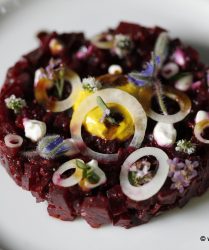Blood of the Earth is
the first column from the series DISH!
–
I love beetroots, they are so unassuming, but there aren’t many vegetables with quite the same substance and elegant potential. Dress them down and they are comfortable in a farm kitchen as borscht, perfect with the thick sour cream of Eastern Europe. But give them a little love and they can make chicken consommé sparkle like a ruby, fit for a royal banquet. They can stand up to strong flavours with ease and so make a great side salad to smoked mackerel or salmon. Assertive as they are, though, they don’t tend to overpower other ingredients, but instead can accentuate their character. Add some young golden beets among the potatoes around your next roast chicken, for example, tossed with olive oil and thyme, and notice how the sweetness of the meat is brought to the foreground.
My only beef with beetroot is that it’s so often neglected, or even worse, mistreated. Boiled until soft, so much of its colour and soul leached into the cooking water, how can it not disappoint us with insipidness? There are better, if slower, ways to allow beetroot to live up to its full potential, and my favourite is roasting it in a salt crust. Rather than weaken, its savouriness intensifies as it roasts, while its texture relaxes and becomes more tender.
A salt crust is a simple mixture of, usually coarse, salt and egg whites. Mix about half a kilo of coarse sea salt with the white of one egg until the whole mixture feels like wet sand and roughly holds its shape when pressed together between your palms. Within this treasure, encase your one large blood-red beetroot and one golden beetroot, washed well, but left with their skin on. It’s easiest to do this in a small roasting pan. The key is to make sure the crust has no gaps or cracks and the beetroots are nestled safely within it. Place them in a 180°C oven for 2 hours.
When you take them out, break the crust with a knife, and when the roots are cool enough to handle peel them and dice the red one(s) in half-centimeter pieces. After you marvel at your blood-stained hands, it’s time to assemble your tartare.
As with the meaty version of this dish, the balance of the mixture is subject to personal preferences, so use your taste buds and good sense, not just my words. My current taste dictates that for every portion I combine a loose half cup of diced beetroot, a quarter teaspoon of red miso paste, a few drops of aged balsamic vinegar, a few drops of Worcestershire sauce, half a teaspoon wholegrain mustard, one and a half tablespoon diced cornichons, half a tablespoon finely diced shallots, half a teaspoon of diced capers (I like the ones preserved in salt, rinsed well before using), a glug of the best olive oil in the house, and a few dashes of Tabasco. Mix this well until everything is even throughout. Taste for salt and add accordingly.
The golden beetroot should be puréed in a blender with some smoked salt and enough olive oil to make a firm golden cream that holds its shape when spooned. It helps to make more of this than you need; it’s perfect on some toast with some smoked mackerel and sour cream.
To assemble, place your tartare in the middle of a plate, in a ring if you have such things and top with a rounded tablespoon of the golden cream. I like to decorate with a few dots of sour cream, dainty rings of sliced red shallot, herb flowers, a dusting of smoked paprika, and a drizzle of olive oil. Serve with toasted crusty bread, a lightly dressed green salad, and extra Tabasco on the side.
TEXT TASSOS SARAMPALIS | PHOTOGRAPHY SANDER MARTENS
DISH is the brainchild of two friends, Sander Martens and Tassos Sarampalis. Though they come from very different parts of the world, they are both inspired by food; Sander as a photographer and Tassos as food writer. Together, they explore the taste and nature of food, visually, culturally, and artistically, influenced by their international and local experiences. The column is published every two months in Villa d’Arte (Kookkunst).
© Sander Martens & Tassos Sarampalis, all rights reserved









Tassos, you are an artist! I will try this recipe, and add it to my simple much more pedestrian ones. Funny, I just came home from Japan and, starved for vegetable-vegetable dishes, picked up two bunches of very dirty golden beets at the bowl (88 c each, organic) and subjected them to my usual treatment: put the unwashed bulbs in a 180C oven for 1 hr, wahed the greens, separated the leaves from the stems, chopped the stems into 2-mm pieces, added them to half-a bulb of chopped garlic to sautee them slowly in cooking olive oil, to which I added the chopped leaves, salt, and pepper. By the time these were done, so were the bulbs, which could be peeled in 15 sec, cut into 1-cm slices that were added to the garlicky green stuff. Served with Cinnie’s impromptu idea of monkfish slices marinated in a salty dip of lemoncello, cooked for 5 mins in a sauce of reduced butternut squash soup to which 1 dl of limoncello was added with salt and pepper. We licked or plates while rinsing our mouths with a decent chardonnay, and gave thanks for living 15 mins from the Bowl. But you can fake this even away from Berkeley.